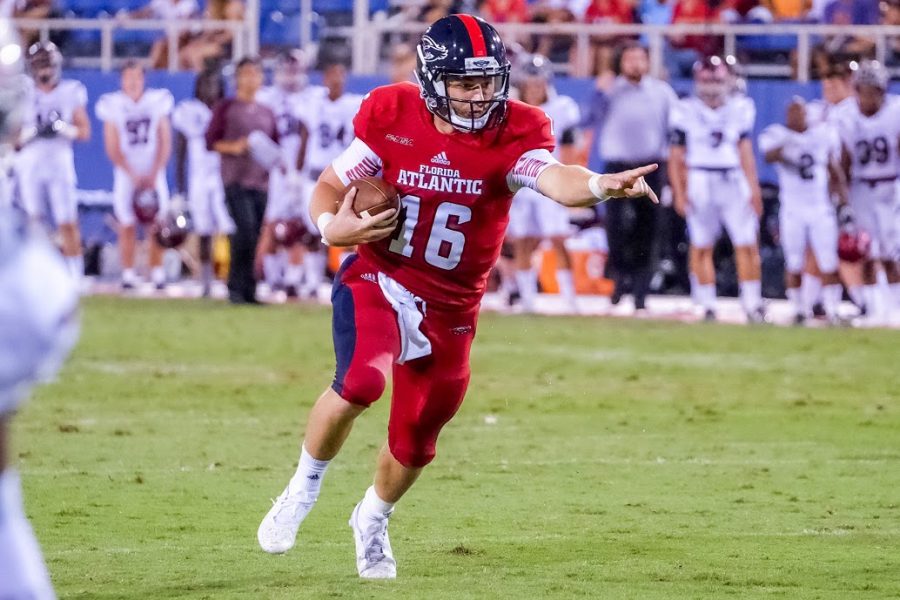Football: Travis Trickett’s new offense passed first test last Saturday, faces tougher challenge tomorrow
The new offensive coordinator brought with him a much faster offense than the Owls previously ran under former coordinator Brian Wright.
Redshirt sophomore Jason Driskel scrambles during FAU’s victory last Saturday. Mohammed F. Emran | Staff Photographer
September 9, 2016
F
ast paced, no huddle. Spread. High scoring. No huddle, no mercy. Explosive.
Many words have been used to described Travis Trickett’s offensive style, but all have come from the same concept — wherever Trickett goes, he is followed by a potent offense.
His first year as a graduate student coach in 2009 at Florida State University, Trickett worked with future NFL quarterbacks Christian Ponder and E.J. Manuel, both of whom became first-round draft picks. The Seminoles jumped from the 37th highest scoring offense to the 25th upon Trickett’s arrival.
In 2010, Trickett’s last season at FSU, his future school Samford University scored 17.8 points per game. After joining the program as an assistant coach the next year, the offense raised its average to 28.3 points.
In the subsequent four seasons with the Hattiesburg, Mississippi native as offensive coordinator, the team scored 30.4 points per game, including marks of 32.3 and 34.6 in his final two years before heading to Boca Raton.
Along with his first impression when Samford played his previous employer Arkansas University, that fast paced, no-huddle offense became the key reason head coach Charlie Partridge appointed Trickett as his new offensive coordinator after the 2015 season concluded — one which the Owls finished ninth out of 12 Conference USA programs after opponents limited them to 22.1 points per game.
The change in tempo, which is most responsible due to the sacrifice of the huddle, was first displayed in FAU’s 2016 spring game where the projected starting offense scored 55 points against the presumed second team, leaving room for potential critics to question its game effectiveness.
Saturday’s season opener became the first true test of what the system was capable of.
Explosive
The first word to stand out during the Saturday’s game was explosive. Aside from three plays, the Owls failed to reach 100 total yards of offense in the first half.
However, those three other plays accounted for 170 yards, each resulting in a touchdown.
The first came during FAU’s second play from scrimmage. Junior running back Greg Howell received his first handoff of the season from his quarterback and carried the ball 48 yards toward his fellow classmates in the student section for a touchdown.
Eight minutes and two possessions later, Howell received his third handoff of the game. He took that 37 yards into the end zone.
“When we execute, [the defense] can’t stop us,” Howell said after the game. “We’re the only ones that can stop us.”
Then, with halftime 45 seconds away, the Owls began a drive on their own 15-yard line. Driskel threw a pass deep down the left hash marks intended for redshirt junior Kalib Woods.
The ball bounced off Woods’ hands before deflecting off two opponents and dropping into the hands of redshirt freshman wide receiver Tavaris Harrison, who coasted for an 85-yard touchdown.
“There’s a lot of things I’m very, very excited about coming out of that game, starting with our offense,” Partridge said. “Our offense showed signs of explosion.”
Fast Paced
After an inconsistent first half, FAU came out of the halftime gates in rhythm. The offense scored a touchdown in three of its first four drives, two of which took less than five minutes to complete.
Driskel connected on 12 of his first 13 pass attempts, including nine straight to start the half. He found junior wide receiver Henry Bussey and graduate student tight end Tyler Cameron for two touchdowns through the air, along with a two-yard touchdown scramble of his own.
Partridge noted the advantage the fast-paced system gave to his team.
“You were starting to see the value of our style of offense, starting to wear down the opponent,” he said. “You started to see it and our players felt it and that was maybe the most enjoyable thing, to see our guys recognize that we were starting to wear our opponent down and they were feeding off of that.”
Looking Forward
In attempt to reassure his offense at halftime, Partridge told them not to change.
“The biggest thing was to just stay with the plan and have faith, I mean that really was what it was,” he said.
Going forward, the team should hold onto those words. Trickett has proven that points tend to follow him.
As Howell said, “When we do what we got to do, we’re very successful. When you trust in a system you get a great outcome.”
Trickett’s offense will face its toughest challenge to date this Saturday, when they travel down the highway to take on the University of Miami Hurricanes, who are coming off a 70-3 first week win over Florida A&M University.
Brendan Feeney is the sports editor of the University Press. For information regarding this or other stories, email brendanrfeeney@gmail.com or tweet him @feeney42.






